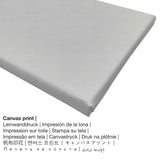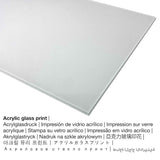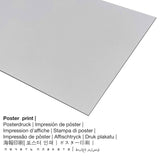Paul Cézanne - The Large Bathers (Les Grandes bathers) - fine art print
Tax included. Shipping calculated at checkout.
Specifications of the art product
This masterpiece was created by the male painter Paul Cézanne. The original measures the size - Overall: 52 1/8 x 86 1/4 in (132,4 x 219,1 cm). Oil on canvas was used by the painter as the technique for the work of art. Today, this artpiece is included in the Barnes Foundation's art collection. With courtesy of: Courtesy of the Barnes Foundation, Merion and Philadelphia, Pennsylvania (public domain).Besides, the work of art has the creditline: . Moreover, alignment is landscape and has a ratio of 16 : 9, which implies that the length is 78% longer than the width. Paul Cézanne was a painter of French nationality, whose style can mainly be classified as Impressionism. The French artist lived for a total of 67 years, born in the year 1839 and passed away in the year 1906 in Aix-en-Provence.
Get your desired product material
We offer a range of different materials and sizes for every product. The following sizes and materials are the options we offer you for individualization:
- Acrylic glass print (with real glass coating): The print on acrylic glass, which is sometimes referred to as a UV print on plexiglass, makes the original work of art into marvellous décor. Your favorite artwork is being printed with the help of modern UV direct printing machines. The result of this are impressive, vivid colors. The major benefit of a plexiglass fine art print is that contrasts and image details become more exposed due to the granular tonal gradation.
- Canvas print: The printed canvas, not to be confused with an artwork painted on a canvas, is an image printed from an industrial printing machine. Canvas prints are relatively low in weight, meaning that it is quite simple to hang up the Canvas print without extra wall-mounts. Therefore, canvas prints are suitable for any type of wall.
- Poster print on canvas material: The Artprinta poster print is a printed sheet of canvas with a slight structure on the surface. Please note, that depending on the size of the poster we add a white margin of approximately 2-6cm around the print motif to facilitate the framing.
- Aluminium dibond (metal print): An Aluminium Dibond print is a material with an impressive depth, creating a contemporary look throuch a surface , which is not reflective. A direct Direct Print on Aluminum Dibond is the perfect start to art replicas produced on aluminum. For the Direct Aluminium Dibond option, we print the artwork right on the aluminium white-primed surface. The colors of the print are luminous, fine details of the print appear clear and crisp. The direct print on aluminium is the most popular entry-level product and is a sophisticated way to display fine art reproductions, because it puts the viewer’s attention on the image.
Important note: We try everythig possible to describe our art products with as many details as possible and to showcase them visually in our shop. At the same time, some pigments of the print products and the print result can differ slightly from the image on the device's monitor. Depending on your screen settings and the condition of the surface, not all colors can be printed as exactly as the digital version on this website. Given that our art reproductions are processed and printed manually, there might as well be slight discrepancies in the motif's exact position and the size.
Structured item details
| Article categorization: | art copy |
| Reproduction: | reproduction in digital format |
| Production process: | UV direct printing (digital print) |
| Product Origin: | made in Germany |
| Stock type: | on demand |
| Intended product use: | art print gallery, home design |
| Image alignment: | landscape alignment |
| Image ratio: | length to width 16 : 9 |
| Interpretation: | the length is 78% longer than the width |
| Available reproduction fabrics: | acrylic glass print (with real glass coating), canvas print, poster print (canvas paper), metal print (aluminium dibond) |
| Canvas print (canvas on stretcher frame) size variants: | 90x50cm - 35x20", 180x100cm - 71x39" |
| Acrylic glass print (with real glass coating) size variants: | 90x50cm - 35x20", 180x100cm - 71x39" |
| Poster print (canvas paper) options: | 90x50cm - 35x20" |
| Aluminium print size options: | 90x50cm - 35x20" |
| Frame: | not included |
Background information about the unique work of art
| Name of the painting: | "The Large Bathers (Les Grandes bathers)" |
| Artwork categorization: | painting |
| Original medium: | oil on canvas |
| Artwork original size: | Overall: 52 1/8 x 86 1/4 in (132,4 x 219,1 cm) |
| Museum / collection: | Barnes Foundation |
| Place of museum: | Philadelphia, Pennsylvania, United States of America |
| Museum's website: | Barnes Foundation |
| License type of artwork: | public domain |
| Courtesy of: | Courtesy of the Barnes Foundation, Merion and Philadelphia, Pennsylvania |
About the artist
| Artist: | Paul Cézanne |
| Gender of the artist: | male |
| Nationality of artist: | French |
| Professions: | painter |
| Country: | France |
| Styles: | Impressionism |
| Life span: | 67 years |
| Birth year: | 1839 |
| Died in the year: | 1906 |
| Place of death: | Aix-en-Provence |
This text is copyrighted © | www.artprinta.com (Artprinta)
General description from the museum (© Copyright - Barnes Foundation - www.barnesfoundation.org)
In the last decade of his life, Paul Cézanne produced three enormous multi-figure bathing scenes that are often regarded as the culminating works of his career. Of these, the largest and most resolved is at the Philadelphia Museum of Art; another is at the National Gallery, London. The present canvas, which Albert Barnes acquired in 1933, is in many ways the most ambitious of the trio. Probably begun around 1895, The Large Bathers is an intensely physical painting that seems to have consumed Cézanne for roughly ten years; a photograph taken in 1904 shows the picture in a still-unfinished state. But even without this documentary evidence, the canvas bears the marks of a long, labored working process, with a surface so impossibly thick with paint that it rises up in clumps in some areas and forms sculptural ridges in others.The subject is perfectly conventional: a group of nudes relaxes in a landscape, with trees arching overhead and still-life elements in the foreground, tropes borrowed from a long tradition of pastoral imagery. There is nothing conventional, however, about the way this scene is painted. While Cézanne's contemporaries often presented bathers in harmony with the landscape, here nature seems menacing, and the landscape's relationship to its human inhabitants is difficult to understand. Clouds are heavy, with an almost oppressive weight, and the blue sky peeking through them is rendered with paint so thick that it literally projects. One tree leans into the center, its sharp branches cutting aggressively across the sky in three parallel spokes. One wonders why, in this scene that presumably takes place in summer, these branches are bare; patches of green in the background suggest foliage, but the foreground trees around which the bathers gather are emphatically, eerily, dead.The figures themselves are at once beautiful and unsightly. They are elegantly arranged, in postures borrowed from classical sculpture and baroque painting. An unusual ridge of thick blue paint surrounding each of the figures lends the group an air of slowness, or serenity, even as it suggests artistic struggle. Colors are often breathtaking, as in the reds that spread across cheeks and hair, and in the pale blues and lavenders that suggest shadows. At the same time, Cézanne undermines 19th-century standards of beauty: skin is composed of patches that shift suddenly from one color to the next, and gender is difficult to read. Is the bather leaning against the tree a man or a woman? Paint pulled down between that figure's legs seems to want to obliterate sex. Anatomies are distorted, sometimes to disturbing effect—feet, hands, and fingertips often do not exist. The face of the figure leaning against the tree registers as a blank, with features buried beneath a blanket of brushstrokes. Even more jarring is the walking figure at left, whose towel cascades theatrically into the foreground but whose head is a mere knob of flesh. The 1904 photograph reveals that thisfigure did at one time have a fully resolved face and head, but Cézanne painted it out, in just one of this picture's many radical moments.Martha Lucy, The Barnes Foundation: Masterworks (New York: Skira Rizzoli, 2012), 66-67.














